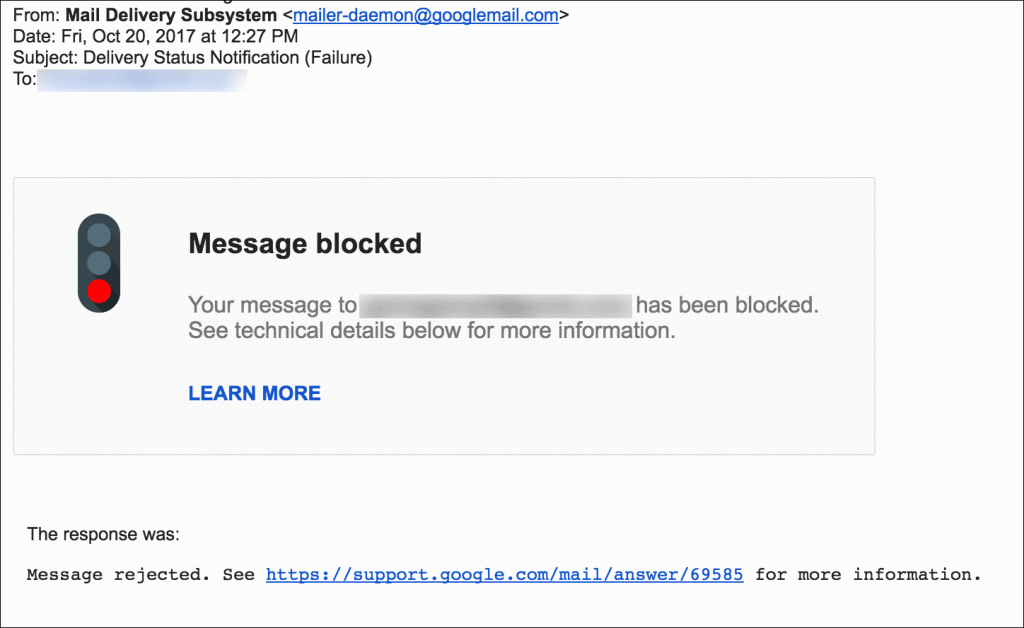Gmail Open: Gmail’s 69585 bounces & what they mean
Gmail’s 69585 bounces and what they mean
Gmail Open: For upon |Have you ever gotten a bounce after sending an email from Gmail with a 69585 bounce code that references a URL? Specifically, a bounce message that says: Gmail Open.
Your message to john@smith.com has been blocked. See technical details below for more information. LEARN MORE The response was: Message rejected. See https://support.google.com/mail/answer/69585 for more information.
Here’s a screenshot:

Gmail provides a broken URL and little information
You might notice that the URL that Gmail gives for more information about the 69585 bounce is a broken URL. In fact, it redirects to a webpage that has nothing to do with the 69585 bounce: Gmail Open.
https://support.google.com/mail/answer/6596?visit_id=1-636469950368928843-4158290028&rd=1
It doesn’t explain the 69585 bounce at all. So what’s the deal? We’re not sure why Google removed the explanation page for the 69585 bounce code, but in the past, it meant that Google blocked the email on its way out of Google’s network. The email never reached the server for the particular email address. Whereas most blocks are blocked by the receiver, a 69585 bounce is a preemptive block by Google, because they think the email you’re trying to send is spam. Gmail Open
Surprisingly, there’s almost no good information on the web about this bounce code. The best explanation we can find directly from Google is here:
https://productforums.google.com/forum/#!msg/gmail/uH2hN6S5OyM/lzdteH-ifvYJ
The relevant part of the explanation is:
Gmail Account
To clarify: the issue discussed on this thread is when @gmail.com users are attempting to send an email to multiple recipients (in some cases, a large number of recipients) and their outgoing mail is getting blocked by our system and is never delivered. If you’ve arrived at this thread and this is not your issue, please try using the search bar at the top to find a more relevant thread. Gmail Open.
With that being said, this behavior will still occur in certain instances. The free version of Gmail was not intended to be used as a business email or regularly send to large groups of people. If that is what you are attempting to do, we recommend using Google Groups or Google Apps for Work (if you’re a business). Google Groups allows recipients to opt-in, so you can ensure you’re not sending unwanted mail, and Google Apps for Work will allow you to more professionally and reliably communicate with your customers. Gmail Open.
While I agree with this statement, it’s worth noting that in most cases, it is possible to send a mail merge or a group email to multiple recipients from a regular Gmail account, especially if the Gmail account being used has a long history with Google and is established as a legitimate account belonging to a real person. The history and age of the account are the factors in determining it’s sending limits and general mass email-sending ability. Gmail Open.
Real-time 69585 data in GMass
Just for fun, here’s a live data feed showing how many 69585 bounces GMass has generated recently when sending emails through users’ Gmail and Google Workspace accounts. Note that GMass sends about 5 million total emails/day for about 10,000 users/day.
| Date | 69585 Blocks | Users Affected |
|---|---|---|
| 04/26/2022 | 776 | 76 |
| 04/25/2022 | 4,572 | 305 |
| 04/24/2022 | 2,051 | 115 |
| 04/23/2022 | 1,372 | 149 |
| 04/22/2022 | 2,176 | 242 |
| 04/21/2022 | 3,246 | 365 |
| 04/20/2022 | 2,774 | 292 |
| 04/19/2022 | 3,123 | 295 |
| 04/18/2022 | 3,486 | 378 |
| 04/17/2022 | 2,879 | 189 |
| 04/16/2022 | 2,952 | 221 |
| 04/15/2022 | 3,944 | 374 |
| 04/14/2022 | 4,706 | 465 |
| 04/13/2022 | 4,770 | 455 |
| 04/12/2022 | 4,325 | 326 |
What should you do if you’re sending a mail merge and you get 69585 bounces?
- Try to isolate the content issue that’s resulting in the 69585. Play around with your content, and then send the email to one of your recipients, and see if you get the same bounce. If you don’t, you’ve probably happened upon the solution. Gmail Open.
- GMass will categorize these bounces as “blocks”, meaning you can send a follow-up to all the “blocks” with just a couple of clicks. You don’t have to manually go through all the 69585 bounces to determine who received your email and who didn’t. Gmail Open.
- You can also get around Gmail’s limitations altogether by connecting your account to a third-party email-sending service like Sendgrid or JangoSMTP. If you do that, you can send virtually unlimited emails, and you will never be in danger of getting a 69585 bounce or an over-limit bounce. Gmail Open.
The article was originally published here.


Comments are closed.